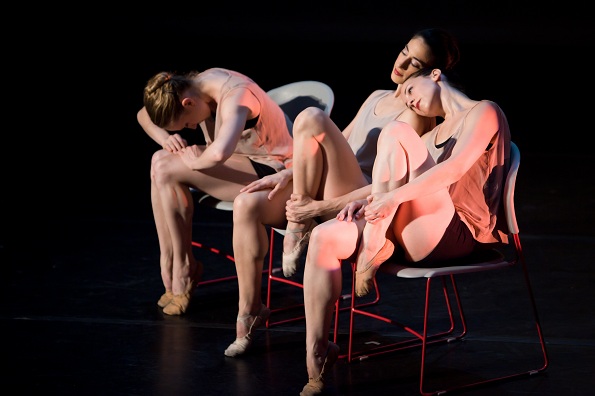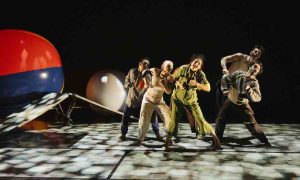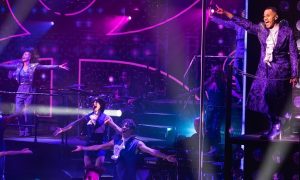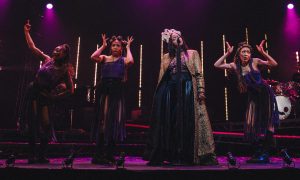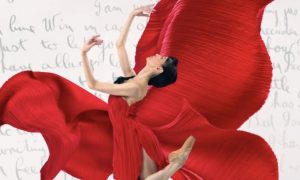By Laura Di Orio.
While each choreographer seems to have his/her own process during the creation of a work, most seem to share a common driving force: music. Whether the choreography stems from a piece of music or a choreographer needs to search for music to suit the movement’s needs, the importance of the relationship between dance and its accompanying music in undeniable. Here, Dance Informa speaks with a few choreographers about their musical inspirations and processes.
What inspires you musically? What is it about a certain piece of music that moves you to choreograph?
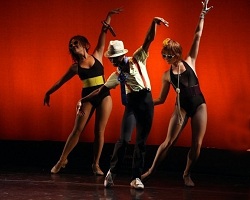
Christopher Liddell and dancers. Photo by Bill Hebert
Christopher Liddell, theater dance choreographer
www.cliddellchoreography.com
First, I’ve got to feel it in the gut, whether it’s because the lyrics spin a great tale or the music itself paints a robust picture. A great arrangement is key, containing at least three ‘acts’ or movements: plot intro, exposition and/or conflict, resolution. And I like when it’s catchy enough for the audience to hum on their way out.
Lar Lubovitch, choreographer, Lar Lubovitch Dance Company
www.lubovitch.org
It’s not totally conscious, but I’m certainly looking for something that makes me need to dance and that triggers my inner eye. My response to music is in effect making an action painting for the music.
What comes first for you – the choreography or the music?
Lydia Johnson, choreographer, Lydia Johnson Dance
www.lydiajohnsondance.org
I think that’s changed. It used to be music first, but in the last four or five years what started to happen was whatever I’m working on is kind of coming of its own accord and is growing independently from music. I’m starting to get a feeling or see images and then I’m searching for music that will work. So now something’s coming from me and then I go through music to find what will work to meet those needs.

Adam Barruch Dance in "Lapse". Photo by Nan Melville
Adam Barruch, choreographer, Adam Barruch Dance
www.adambarruch.com
Usually I find a piece of music that I love and play it repetitively while creation in the studio is in process. I do this so that the physical work generated is steeped in the environment the music creates. Other times, I revert to a playlist on my computer that is full of music that I would never choreograph to, but is there to inspire me.
Christopher Liddell
Music always comes first for me. My process is like this: I pick a song, then I count it and break it into sections, getting the technical aspects down. If the song has lyrics I usually base the dance on the story of the song. I work in musical theater styles. I don’t normally do abstract work. I need the audience to know what is going on and the music choice has to support that.
How do you find music to which you want to choreograph?
Lar Lubovitch
I actually go to a lot of music concerts. I like attending live music events. If I find a composer I like, then I seek out a lot of music by that composer and choose a specific piece with all the ingredients I’m looking for.
Lydia Johnson
Now, because of the Internet, I use a combination of Pandora and iTunes. I put in a composer and make a station on Pandora and play it while I’m doing other things. Then I’ll hear someone who’s really interesting and I’ll go over and find out who the composer is. It’s a way of finding similar composers. I love the Internet for music searches. It’s completely changed by life. I remember having to walk across the street to CD stores or old LP stores and sit there looking at the covers trying to guess if it was something I’d be interested in because you couldn’t listen to excerpts.
Christopher Liddell
I usually pick a song I’ve known for years. I have this ability to memorize every note and instrumentation in a song. It drives people crazy when I hum all the notes of a crazy jazz trumpet! Over a lot of time, when I’ve gotten to know a song really well, I’ll one day realize, ‘Oh, I can choreograph something to this!’
Do you choreograph so that the dancer becomes the music or is it more of a partnership between the body and the music?
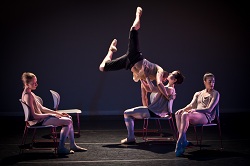
Lydia Johnson Dance in "Summer House". Photo by Brian Krontz
Lydia Johnson
I think some of both. I think there are places that the body is carrying the line of the music and there are places where I think it’s in counterpoint. There are parts of group pieces where different clusters of people will be the music at that moment or a certain movement will be reflecting the music at that moment, but there’s also a lot of counterpoint. So it’s almost a duet with music, and the dancers are expressing something the music makes me feel but not necessarily note for note or exactly what’s happening in the music.
Christopher Liddell
For my work, I try to use the Balanchine method: dance for the music. I think it is my job to paint a picture of the music. The dance and its music should feel completely connected. My goal is for the movement to enhance the music so that the audience ‘hears’ it visually and ‘sees’ it audibly.
Who are some of your favorite musical artists or composers?
Christopher Liddell
I love John Williams. His music is so iconic with his big use of brass. It usually feels good and exciting to listen to. I love Irving Berlin, the Gershwins, and Kander and Ebb for their easily danceable music theater genius. I also love Barbra Streisand, Bebel Gilberto, and yes, I have Bieber fever, too. I’m inspired by his music lately.
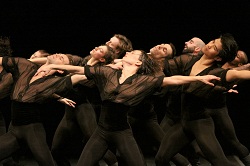
Lar Lubovitch Dance Company in "The Legend of Ten". Photo by Steven Schreiber
Lar Lubovitch
No favorites, just people over the years I’ve responded to very well – Brahms, Mozart, Steve Reich, Philip Glass, and some jazz composers.
Adam Barruch
I really enjoy Purcell and Handel, especially their emotionally rich arias. I also couldn’t possibly listen to Steve Reich and not want to move. I love contemporary artists like Loscil, Murcof, Ryuichi Sakamoto and Amon Tobin, all of whom are playing with a mix of electronic textures and classical sounds. I also love singer/songwriters like Jacques Brel for his poetry, and the work of musical theater composer and lyricist Stephen Sondheim.
Lydia Johnson
Gorecki, Philip Glass, Hindemith. I like a lot of 20th century composers, and then of course Bach and the later Beethoven quartets. I listen to almost everything, but I seem to be drawn lately to living or our lifetime composers.
Top photo: Lydia Johnson Dance in “Summer House”. Photo by Brian Krontz


